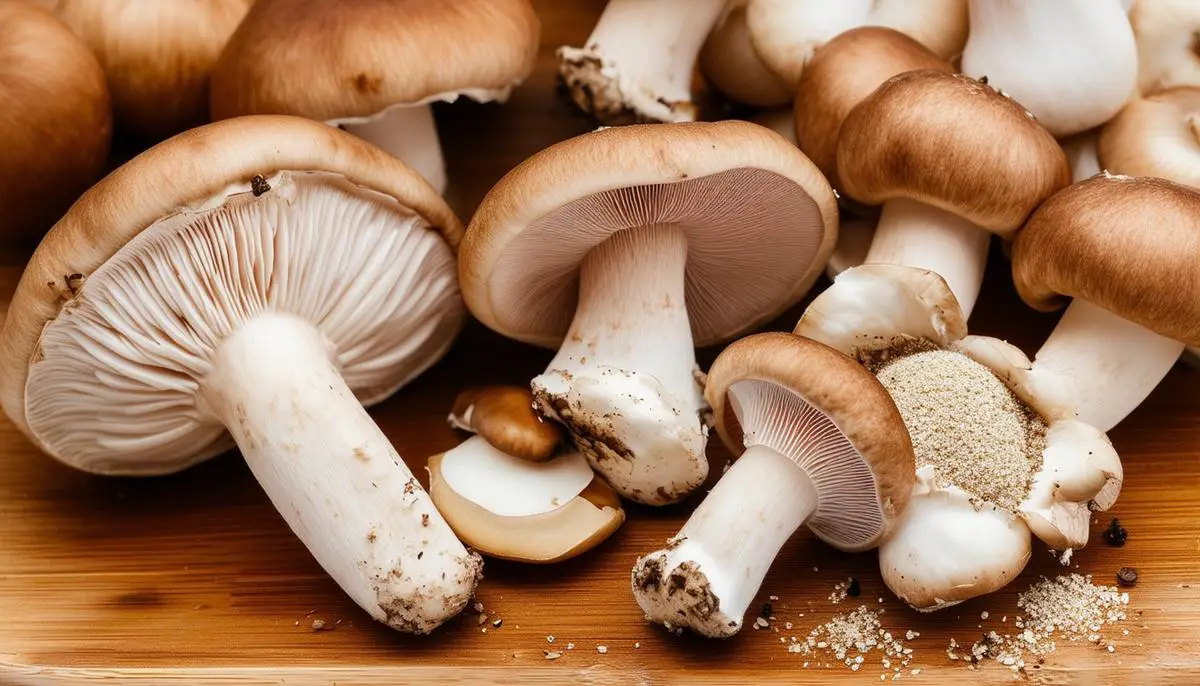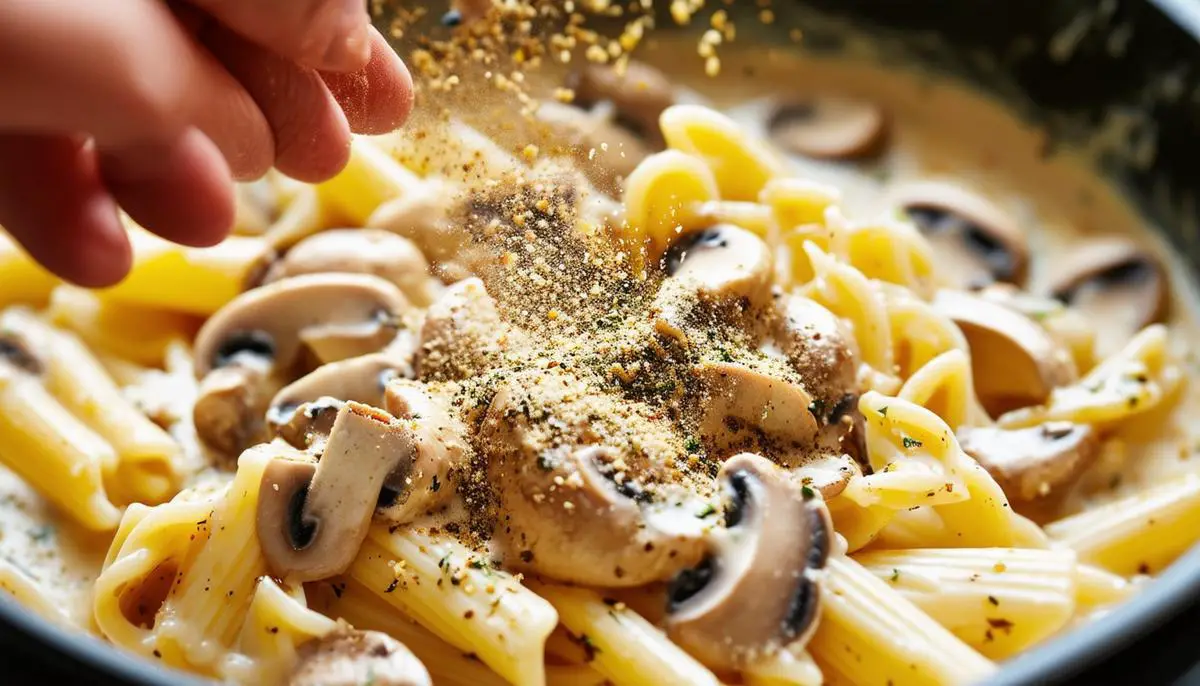
The Rise of Mushroom Seasoning Powder
Mushroom seasoning powder has recently gained recognition for its exceptional health benefits, packed with essential vitamins, minerals, and antioxidants. Known for contributing an umami flavor often described as savory and meaty richness, it elevates a variety of dishes, making it a hit in creative kitchens around the globe. The surge in its popularity is also influenced by the rapid globalization of culinary tastes, where people are exploring ingredients once unfamiliar to their palates.
Chefs and home cooks alike are reaching for mushroom seasoning powder not only to elevate flavor profiles but also to tap into its health advantages. It is particularly rich in selenium, an essential micronutrient that plays a crucial role in maintaining proper immune system function and combating oxidative stress[1]. B-vitamins and minerals found throughout mushroom varieties further bolster its standing as a nutritional powerhouse.
The versatility of mushroom powder is another factor driving its growing appeal. From being a simple add-on to coffee and tea for subtle depth to integrating smoothly into sauces and stews, its ability to blend seamlessly into dishes makes it favored in diverse preparations. Its capacity to offer an extra dimension to vegetarian and vegan recipes particularly stands out, mimicking the satiety and texture typically associated with meat-based components without overpowering dishes.
As culinary experiments continue to flourish and people seek out healthier, enriching, yet delicious alternatives in their diet, mushroom seasoning powder sits confidently at the juncture of taste and health, catering to the evolved global palate. As the appreciation for mushrooms advances beyond traditional uses, it offers potential for novel culinary exploration, supporting modern kitchens with unexpected flavors grounded in natural goodness.
Choosing Your Mushrooms
Choosing the right mushrooms for making mushroom powder is pivotal, as your selection will influence both the flavor and the quality of the final product. Among the plethora of edible mushrooms available, some varieties like shiitake, porcini, and white button mushrooms stand out for their suitability.
Shiitake mushrooms, with their rich, smoky flavor, contribute an intense depth to powders, enhancing the dishes to which they're added. Porcini, prized for their nutty and earthy integrity, render a robustness that can define a savory dish. White button mushrooms, while milder in flavor compared to their exotic counterparts, offer a slightly garlicky and meaty taste, making the powder versatile for a broad spectrum of recipes.
When choosing mushrooms to make powder, ensure that you opt for those that are fresh and firm to the touch. The presence of moisture can be detrimental in the drying process, potentially leading to a less potent flavor and decreased shelf life. Look for mushrooms free from bruises or blemishes, as these are indicative of superior quality and freshness.
Once selected, these mushrooms can be slowly dehydrated to lock in flavor before being ground into a fine powder, enhancing your culinary creations with health benefits and rich flavors.

Creating Mushroom Powder at Home
To begin making mushroom powder at home, cleanliness is paramount. Start by gently wiping the mushrooms with a soft brush or a damp cloth to remove any dirt. It's important not to wash them as water can seep into the pores, making drying more prolonged and less efficient.
Once cleaned, slice the mushrooms as thinly as possible. This increases the surface area, dramatically improving the efficiency of the drying process. Arrange the thin slices on a baking sheet, ensuring they do not overlap, as this would cause uneven drying.
For drying in an oven, preheat it to a low temperature, around 150 to 200 degrees Fahrenheit (about 65 to 93 degrees Celsius). Place the baking sheet in the oven and allow the mushrooms to dry for several hours. The exact time will depend on the thickness of the slices and the type of mushroom. The goal is to achieve a dry and brittle texture.
Alternatively, using a food dehydrator is highly effective. Set the dehydrator according to the manufacturer's instructions for mushrooms. This generally will be at a low setting for multiple hours until completely dry and crisp.
After drying, let the mushroom slices cool to room temperature. Transfer them into a spice grinder or a food processor. Pulse until you achieve a fine powder. The fineness of the powder is preferable for a smooth incorporation into dishes without altering their texture.
Store the mushroom powder in an airtight container, ideally in a cool, dry place. This helps preserve its potency, flavor, and nutritional benefits for an extended period. Keeping it away from direct sunlight will also maintain its quality.
This simple process lets you create a versatile and healthful seasoning right at home, perfect for enhancing a myriad of dishes with a boost of umami flavor.
Culinary Applications of Mushroom Powder
Mushroom powder, due to its intensely savory and subtly earthy tones, provides remarkable versatility in kitchen practices, fulfilling both the functions of taste enhancement and nutritional supplementation. A prime example of its utility is when mushroom powder is added to soups and stews. As a spoonful dissolves into the broth, it introduces a depth of umami that can elevate even the simplest vegetable soup to realms of rich and complex flavors, offering a hearty satisfaction typically associated with meat stocks.
For culinary innovators looking to infuse dishes with nuanced flavors, incorporating this fine powder into sauces is a natural fit. Imagine a creamy mushroom Alfredo sauce or a red wine reduction for steak—both gaining an extra layer of savoriness with a sprinkle of mushroom powder. It dissolves seamlessly, enhancing the sauce's body without roughening its texture.
Mushroom powder also displays a profound adaptability with proteins; chefs might employ it as a dry rub for meats. Coating chicken or beef in a crust of mushroom powder mixed with herbs before roasting can transform the exterior into a tantalizingly crispy yet flavorful crust that enhances, rather than overwhelms, the natural tastes of the meat.
This culinary asset shines equally in vegetarian and vegan cuisines where it mimics the satisfying quality of meat-based elements. A pinch can be whisked into a marinade for tofu or tempeh, adding a savory richness that supports these proteins' natural penchant for flavor absorption. Even sprinkling some powder on roasted vegetables or stirring it into a mashed potato arrangement can boost the flavor profile significantly.
Nevertheless, mushroom powder's capabilities stretch beyond just savory applications. Its subtlety is a valued trait in sweet kitchen creations where it can subtly anchor the flightiness of sugary components. When whisked into chocolate desserts, such as a chocolate ganache or brownies, it can provide an unexpected yet deeply satisfying undertone that complements the natural bitterness of cocoa.
Each use reaffirms mushroom powder's relevance in contemporary cooking spheres, affirming its stature as a pantry essential for those who appreciate culinary excellence and inventive food pairings.

Simple Mushroom Seasoning Powder Recipe
Ingredients:
- 1 cup dried shiitake mushrooms
- 1 cup dried porcini mushrooms
- 1 cup dried white button mushrooms
- 2 tablespoons dried thyme (optional)
- 2 tablespoons garlic powder (optional)
Instructions:
- Combine all dried mushrooms in a large mixing bowl. If opting for additional flavor, add the dried thyme and garlic powder to the mushroom mixture.
- Transfer the mixture to a spice grinder or a food processor equipped with a blade attachment.
- Pulse the mixture several times until you achieve a fine, uniform powder. Pause between pulses to prevent the machine from overheating.
- Once fully ground, sift the powder through a fine mesh sieve to remove any large particles and ensure a smooth consistency.
- Transfer the fine mushroom powder into an airtight container.
- Store the container in a cool, dry place away from direct sunlight to maintain freshness and extend shelf life.
Use this homemade mushroom seasoning powder liberally in recipes to enhance the flavor with a rich, earthy umami touch.
Nutritional information per serving (1 tablespoon):
- Calories: 10
- Protein: 1g
- Carbohydrates: 2g
- Fat: 0g
- Fiber: 1g
- Sodium: 2mg
- Potassium: 45mg
- Falandysz J. Selenium in edible mushrooms. J Environ Sci Health C Environ Carcinog Ecotoxicol Rev. 2008;26(3):256-99.



